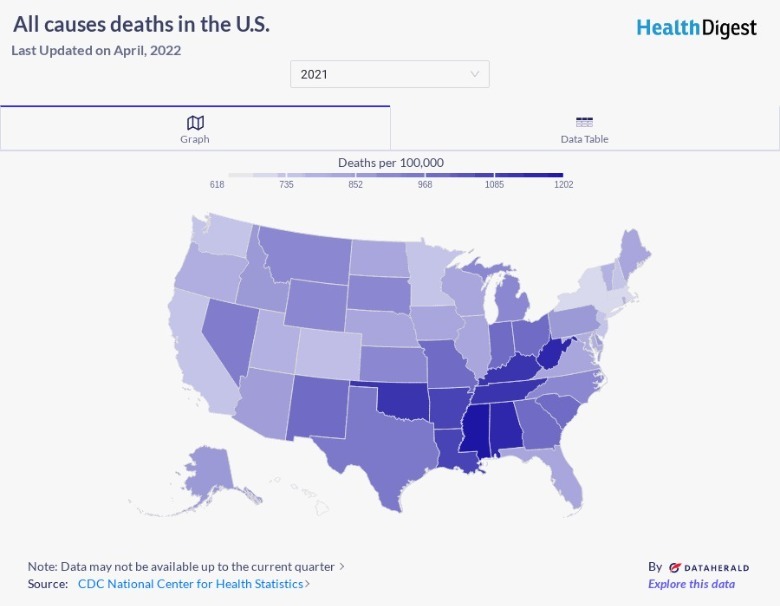Which State In The US Had The Most Deaths In 2021?
With all the headlines about the climbing COVID-19 death toll, it can be easy to forget that the total number of deaths in a year vary wildly state by state. Even beyond COVID-19, yearly death counts differ in states from the southwest to the northeast, and a number of factors affect these disparities.
The U.S. experienced the most deadly year in history in 2021, surpassing 2020's record-setting total (via Associated Press). According to provisional data from the Centers for Disease Control and Prevention (CDC), there were 3.465 million deaths in 2021, up about 80,000 from 2020. The biggest reason for the increase was COVID-related deaths, according to Robert Anderson, who oversees the CDC's work on death statistics. The preliminary data showed that deaths due to cancer and drug overdoses were on the rise, along with rates of diabetes, chronic liver disease, and stroke.
While it's normal for the yearly death count to grow as the country's population grows, the number of deaths in 2020 and 2021 jumped sharply. This, in turn, affects the country's life expectancy at birth, which was 77.0 years in 2020, according to data from the CDC. This number decreased 1.8 years from 2019, which may not seem like much but is actually quite monumental. While data for 2021 isn't yet available, some experts predict that life expectancy may have dropped five or six months more, which would make it where it was 20 years ago (per Associated Press).
America's widening mortality gap
The state with the highest number of deaths per 100,000 in 2021 was West Virginia, followed by Mississippi and Kentucky. West Virginia had 1,232.1 deaths per 100,000, Mississippi had 1,204.5, and Kentucky had 1,139.7. In contrast, states with the lowest death counts were Hawaii, New York, and Connecticut. Hawaii had 630.8 deaths per 100,000, New York had 715, and Connecticut had 720.
Looking at data displayed on the map, it's clear there are regional differences, as states with the highest death counts are concentrated in the South and the South Atlantic. Even though all states have steadily experienced fewer total deaths since the 1960s, the decline has been geographically imbalanced, as states with the highest mortality began to concentrate in the South and the mortality gap widened. But why? The answer is complex, however, there may be geographical differences in environmental exposures, disease control, medical treatment and care, and behavioral risk that can affect mortality, according to a 2013 study published by Population and Development Review.
What's contributing to America's increasing death count?
Rates of poverty by state are incredibly similar to death counts by state, with the highest rates of poverty concentrated in many of the same geographical regions with a higher death toll (per Talk Poverty).
While COVID-19 has greatly contributed to the increase in deaths in 2021, drug overdoses are also on the rise, according to Associated Press. Data on deaths related to overdoses for 2021 aren't yet available, but preliminary data predict that there could be at least 105,000 overdose deaths in 2021. In 2020, the count was 93,000, and adolescent overdoses had nearly doubled from the year before. In states like West Virginia, the 2020 drug overdose death rate was 81.4 per 100,000 (via CDC), in contrast to Hawaii, where the rate was just 18.3 (per CDC).
Despite the Office of Disease Prevention and Health Promotion's Healthy People 2020 goal of ending health and mortality disparities based on geographic location, it seems like we have a long way to go (via Population and Development Review).



